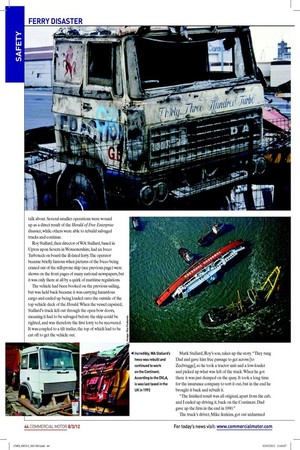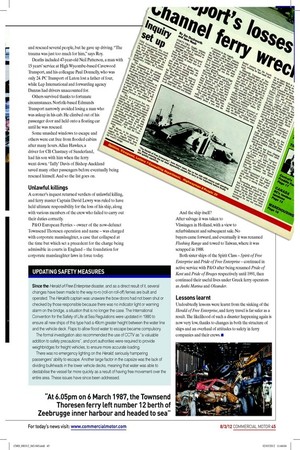Disaster at sea
Page 31

Page 33

Page 34

If you've noticed an error in this article please click here to report it so we can fix it.
FERRY DISASTER
The Herald of Free Enterprise remembered
CM takes a poignant look back at the Herald of Free Enterprise disaster of 1987 and discovers what lessons have been learned since
Words: Lucy Radley / Images: Jan De Wachter There are some events so dramatic, so shocking, that they seem to have happened just yesterday. The Herald of Free Enterprise disaster is one of those, but we have now reached the 25th anniversary of what was later declared to be the worst peacetime British maritime accident since the sinking of the Titanic in 1912.
At 6.05pm on 6 March 1987, the Townsend Thoresen ferry left number 12 berth of Zeebrugge inner harbour and headed to sea. On board were 459 passengers, 80 crew, 81 cars and 47 freight vehicles. At 6.28pm the vessel capsized onto its port side in shallow water, killing 193 people and injuring many more. The formal investigation into the incident concluded the main cause of the accident was a failure to close the inner and outer bow doors, a duty that should have been carried out by assistant bosun Mark Stanley.
Various other factors worsened the situation, such as the need for the ship’s bow ballast tanks to be illed to enable loading of the upper vehicle deck with the single ramp available at Zeebrugge.
Losses keenly felt
With international road transport to continental Europe and beyond still in its heyday, the losses sustained in the disaster were keenly felt across the industry, and to this day those who lost drivers and vehicles ind it dificult to talk about. Several smaller operations were wound up as a direct result of the Herald of Free Enterprise disaster, while others were able to rebuild salvaged trucks and continue.
Roy Stallard, then director of WA Stallard, based in Upton upon Severn in Worcestershire, had an Iveco Turbotech on board the ill-fated ferry. The operator became briely famous when pictures of the Iveco being craned out of the still-prone ship (see previous page) were shown on the front pages of many national newspapers, but it was only there at all by a quirk of maritime regulations.
The vehicle had been booked on the previous sailing, but was held back because it was carrying hazardous cargo and ended up being loaded onto the outside of the top vehicle deck of the Herald. When the vessel capsized, Stallard’s truck fell out through the open bow doors, meaning it had to be salvaged before the ship could be righted, and was therefore the irst lorry to be recovered. It was coupled to a tilt trailer, the top of which had to be cut off to get the vehicle out.
Mark Stallard, Roy’s son, takes up the story. “They rang Dad and gave him free passage to get across [to Zeebrugge], so he took a tractor unit and a low-loader and picked up what was left of the truck. When he got there it was just dumped on the quay. It took a long time for the insurance company to sort it out, but in the end he brought it back and rebuilt it.
“The inished result was all original, apart from the cab, and I ended up driving it, back on the Continent. Dad gave up the irm in the end in 1990.” The truck’s driver, Mike Jenkins, got out unharmed and rescued several people, but he gave up driving. “The trauma was just too much for him,” says Roy.
Deaths included 47-year-old Neil Patterson, a man with 15 years’ service at High Wycombe-based Cavewood Transport, and his colleague Paul Donnelly, who was only 24. PC Transport of Luton lost a father of four, while Lep International and forwarding agency Danzas had drivers unaccounted for.
Others survived thanks to fortunate circumstances. Norfolk-based Edmunds Transport narrowly avoided losing a man who was asleep in his cab. He climbed out of his passenger door and held onto a loating car until he was rescued.
Some smashed windows to escape and others were cut free from looded cabins after many hours. Allan Hawkes, a driver for CB Chastney of Sunderland, had his son with him when the ferry went down. ‘Taffy’ Davis of Bishop Auckland saved many other passengers before eventually being rescued himself. And so the list goes on.
Unlawful killings
A coroner’s inquest returned verdicts of unlawful killing, and ferry master Captain David Lewry was ruled to have held ultimate responsibility for the loss of his ship, along with various members of the crew who failed to carry out their duties correctly.
P&O European Ferries – owner of the now-defunct Townsend Thoresen operation and name – was charged with corporate manslaughter, a case that collapsed at the time but which set a precedent for the charge being admissible in courts in England – the foundation for corporate manslaughter laws in force today. And the ship itself?
After salvage it was taken to Vlissingen in Holland, with a view to refurbishment and subsequent sale. No
buyers came forward, and eventually it was renamed Flushing Range and towed to Taiwan, where it was scrapped in 1988.
Both sister ships of the Spirit Class – Spirit of Free Enterprise and Pride of Free Enterprise – continued in active service with P&O after being renamed Pride of Kent and Pride of Bruges respectively until 1991, then continued their useful lives under Greek ferry operators as Anthi Marina and Oleander.
Lessons learnt
Undoubtedly lessons were learnt from the sinking of the Herald of Free Enterprise, and ferry travel is far safer as a result. The likelihood of such a disaster happening again is now very low, thanks to changes in both the structure of ships and an overhaul of attitudes to safety in ferry companies and their crews. ■
UPDATING SAFETY MEASURES
Since the Herald of Free Enterprise disaster, and as a direct result of it, several changes have been made to the way ro-ro (roll-on roll-off) ferries are built and operated. The Herald’s captain was unaware the bow doors had not been shut or checked by those responsible because there was no indicator light or warning alarm on the bridge, a situation that is no longer the case. The International Convention for the Safety of Life at Sea Regulations were updated in 1990 to ensure all new ships of this type had a 49cm greater height between the water line and the vehicle deck. Flaps to allow flood water to escape became compulsory.
The formal investigation also recommended the use of CCTV as “a valuable addition to safety precautions”, and port authorities were required to provide weighbridges for freight vehicles, to ensure more accurate loading.
There was no emergency lighting on the Herald, seriously hampering passengers’ ability to escape. Another large factor in the capsize was the lack of dividing bulkheads in the lower vehicle decks, meaning that water was able to destabilise the vessel far more quickly as a result of having free movement over the entire area. These issues have since been addressed.








































